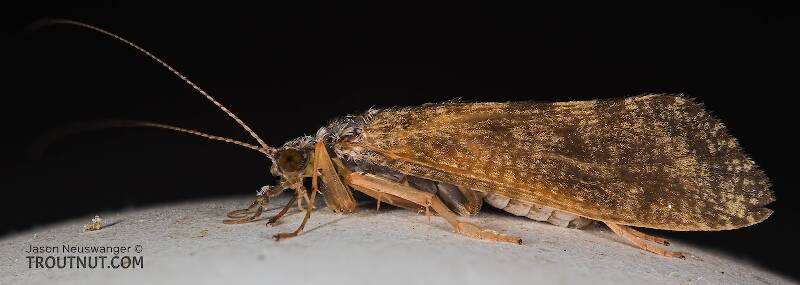
Salmonflies
Pteronarcys californica
The giant Salmonflies of the Western mountains are legendary for their proclivity to elicit consistent dry-fly action and ferocious strikes.


Mayfly Species Plauditus dubius (Tiny Blue-Winged Olives)
Species Range
Nymph biology
Substrate: Gravel, vegetation
Physical description
Most physical descriptions on Troutnut are direct or slightly edited quotes from the original scientific sources describing or updating the species, although there may be errors in copying them to this website. Such descriptions aren't always definitive, because species often turn out to be more variable than the original describers observed. In some cases, only a single specimen was described! However, they are useful starting points.
Male Nymph
This species shows considerable sexual dimorphism in the nymphal stage, the males having contrasting pale and dark maculation and the females being more obscurely marked.
Head and mouth parts: Pale.
Thorax: Pronotum pale in medial area, laterally scattered brown markings on pale background; mesonotum mostly brown with small irregular paler areas; wing pads pale; legs pale, slight darkening at end of tibia and tarsus; claws pectinate.
Abdomen: Very strikingly marked, segments 3 and 4 and 8-10 being pale with the exception of submedial dark dots in the middle of the segments, segments 1 and 2 with more extensive dark areas and segments 5-7 dark with pale anterolateral corners and flanges; venter of segments 5-7 with median and lateral dark patches; caudal filaments pale with a conspicuous dark band half way out, the median filament relatively long, being about as long as the width of a lateral filament at the base; gills on segments 1-7 without distinct tracheae. The Ottawa river males differed somewhat in minor points. They were slightly larger (4.1 mm.); thorax more uniformly brown and on abdominal segments 8 and 9 four instead of two submedian dots; gills with faint tracheae.
Female Nymph
This species shows considerable sexual dimorphism in the nymphal stage, the males having contrasting pale and dark maculation and the females being more obscurely marked.
Head: Vertex with submedial series of brown marks forming an irregularly convoluted line.
Thorax: Brownish with scattered obscure paler areas.
Abdomen: Not as strikingly marked as in the male; mostly dark with small pale areas along the anterior borders of the segments forming a median row and similar pale areas at the posterior borders of the segments forming a submedian row; lateral pale areas on the flanges and a submedian row of dark dots on the dorsum; venter uniformly pale except for dark tracheae laterally; caudal filaments as in the male; gills with fairly distinct tracheae.
Male Spinner
Wing length: 3.5-4.5 mm
Abdominal tergites of male imago hyaline whitish with a faint yellowish tinge.
Turbinate eyes the size of those in P. dubium (now a synonym of Plauditus dubius); in living insect, yellowish green with a purplish-brown band at the base of the stalk; in dried specimen, the eyes are deep purplish, with a wide pale red-brown outer margin. Head shiny black; bases of antennae and ocelli ringed with greenish. Thorax blackish, shining; lateral sutures (of pleura) pale; anterior portion of mesonotum shaded slightly with greenish. Legs whitish; fore femur smoky. Wings hyaline. Abdominal segments 2-6 hyaline, with faint yellowish tinge. Tergites 7-10 pale brown, ruddier than in P. punctiventris (now a synonym of Plauditus punctiventris); sternites paler, more or less tinged with pale brown. A faint brown line marks the spiracular area. Tails white.
This species is very close to P. dubium, and may prove to be synonymous with it; the color of the eyes in the living insect is the main distinction.
Described as P. dubium
Body length 2.5-4 mm, wing length 3.5-4.5 mm
Abdominal tergites 2-6 of male imago hyaline white, usually with black spiracular markings.
Turbinate eyes almost circular; ruddy brown in living specimens. Thorax shiny black. Legs pale. Wings hyaline. Abdominal segments 2-6 hyaline white; a dark dot over each spiracle, usually a pale hyaline center in each. Tergites 7-10 pale umber brown (piceous, in original description); sternites opaque whitish. Genitalia as in fig. 168.
Start a Discussion of Plauditus dubius
References
- Arbona, Fred Jr. 1989. Mayflies, the Angler, and the Trout. Nick Lyons Books.
- Caucci, Al and Nastasi, Bob. 2004. Hatches II. The Lyons Press.
- Ide, F. P. 1937. Descriptions of Eastern North American Species Of Baetine Mayflies with Particular Reference to the Nymphal Stages. The Canadian Entomologist 69(11): 235-243.
- Needham, James G., Jay R. Traver, and Yin-Chi Hsu. 1935. The Biology of Mayflies. Comstock Publishing Company, Inc.
Mayfly Species Plauditus dubius (Tiny Blue-Winged Olives)
Species Range
Common Names
Resources
- NatureServe
- Integrated Taxonomic Information System
- Global Biodiversity Information Facility
- Described by Walsh (1862)

